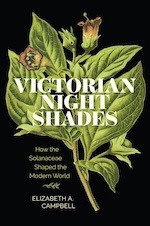Today, we are happy to bring you our conversation with Elizabeth A. Campbell, author of Victorian Nightshades: How the Solanaceae Shaped the Modern World
What inspired you to write this book?
This book grew out of my professional interest in Victorian literature and an amateur interest in botany. In British parlance, I’m a “flower-spotter,” and I fell in love with the nightshades forty years ago when I first saw bittersweet (Solanum dulcamara) blooming profusely beside a creek in southwestern Pennsylvania. I was permanently hooked after reading in my Audubon Guide to North American Wildflowers, Eastern Region, that bittersweet was “sometimes called Deadly Nightshade,” and was “used in England to counteract witchcraft.” These titillating bits of information inspired flower-spotting trips of a literary sort, first through the old English herbals and on to the vast, various body of Victorian information about plants, whether scientific, like botanies, horticultural magazines, and pharmaceutical works, or sentimental, as in fiction and the language of flowers.
What did you learn and what are you hoping readers will learn from your book?
The most important thing I’ve learned is how the study of plants leads to a broad grasp of history and also an intimate sense of any given era--its daily life and habits, health, beliefs, fears, and pleasures. The nightshades are particularly enlightening because of their global importance as food and drugs. For example, historical knowledge about a food staple like the potato is essential for understanding both Andean and Irish cultures. And thanks to their powerful alkaloids like atropine in belladonna and nicotine in tobacco, the Solanaceae offer valuable insight into pharmaceutical history. In the Victorian period these two potent nightshades exemplify, respectively, how a reviled poisonous plant became an essential medicine and a plant introduced to Europe as medicine became an addictive poison.
What surprised you the most in the process of writing your book?
The rich lore surrounding the nightshades makes researching them full of surprises, but I probably was most surprised--and delighted--to learn that bittersweet made it into Victorian popular culture curiously disguised as a quack. Dr. Dulcamara in Gaetano Donizetti’s 1832 comic opera L'elisir d'amore became a satirical presence in Punch cartoons and elsewhere to attack charlatans of every stripe, eventually becoming a character in a W. S. Gilbert burlesque. This adaptation of the plant’s species name alluded to bittersweet’s important place in homeopathy, which was just coming into widespread practice, but was often panned in the press and by the mainstream medical community for its method of diluting substances to such an infinitesimal degree that none of their original ingredients remained.
What’s your favorite anecdote from your book?
My favorite anecdote comes from Charles Dickens recounting his most unusual tobacco-smoking experience, which occurred in Switzerland during the fall of 1846. Writing to his friend John Forster, Dickens tells about spending the evening in a Geneva hotel sharing cigars and cigarettes with two American and two English ladies who smoked incessantly, one of the latter particularly noteworthy for “smoking away like a Manchester cotton mill.” Dickens concludes, “I showed no atom of surprise; but I never was so surprised, so ridiculously taken aback, in my life. For in all my experience of ‘ladies’ of one kind or another, I never saw a woman--not a basket woman or a gypsy--smoke before!” In his next novel Dombey and Son we meet the pipe-smoking crone Mrs. Brown.
What’s next?
As part of work on a book of essays about walking, I’m currently researching the plants growing in the fields I pass on my regular walk. These wayside weeds and wildflowers are a fascinating mixture of native and introduced species, but my interest in the migration of botanical families draws me immediately to Old World species--for example, the wild carrot (Daucus carota), aka Queen Anne’s Lace, which has taken over much of rural America. A member of a large family of common edible vegetables and known by its white flowers forming an umbel--an umbrella-shaped inflorescence--wild carrot is an important species in its own right. And knowing that it’s been fatally confused with its relative poison hemlock increases my interest even more.





